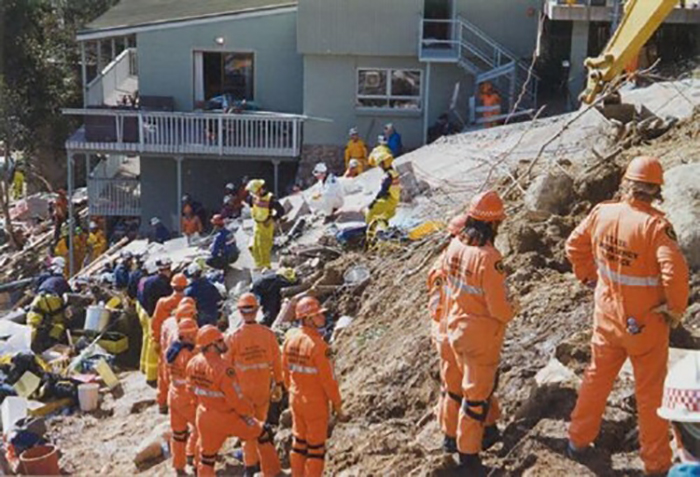USAR Blog: Learning the lessons from Australia's worst landslide
Australia’s worst landslide disaster took place at 23:30hrs on Wednesday 30th July 1997, in Thredbo, an alpine village and ski resort in the Snowy Mountains of New South Wales (NSW), writes Blog Editor Martin Boyle. For most Australians, the name ‘Thredbo’ is synonymous with the devastating disaster that took 18 lives and gave rise to the miraculous rescue of Stuart Diver, who was trapped under three concrete slabs for more than 60 hours.
https://youtu.be/m1q95Fa_jnE
The anniversary has been a time of reflection for all those involved in the disaster. On the night of the twentieth anniversary, 300 skiers paid tribute to those who died by lighting up the Thredbo ski slopes with a silent line of red flares, 18 of which were placed at the top of the slope to honour the victims.
On that cold, snowy night 20 years ago, around a thousand tonnes of mud and rock hurtled down the slope crashing into Carinya Lodge, dislodging and pushing it down onto Bimbadeen Lodge. The impact demolished both buildings and buried 19 people under earth and concrete slabs. The landslide was caused by a leaking water main that saturated the marginally stable fill embankment of the Alpine Way, a road that runs 1.3km above Thredbo village. The ensuing rescue operation was a challenge for emergency services given the remote location, environmental conditions, and dangerously unstable site.

Rescuers at the scene in 1997 (photo reproduced under CC/New South Wales State Emergency Service)
Miraculously, 55 hours into the operation signs of life were detected. A sole survivor was discovered. For 11 hours rescue teams fought hard to free Stuart Diver from the rubble, where he lay in the dark, next to his wife Sally who had drowned, despite his best efforts to save her. Finally freed, an emotional cheer was raised by rescuers, and all Australians alike who had been following the televised rescue. More than 600 rescuers worked on the site over eight days in ambient overnight temperatures of -12°C with wind chill of -30°C.
https://youtu.be/uj8oPaNzDgU
The NSW Coroners report noted that: “Until the Thredbo landslide tragedy there had been little public recognition that landslides were a significant threat in Australia.” This brought the issues and challenges associated with landslides into the public eye. Coroner Derek Hand recommended that the Australian Geomechanics Society Landslide Risk Management Concepts and Guidelines should be adopted, leading to its widespread use throughout Australia. A further recommendation was made to include the risk and management of landslides in Alpine areas in district and local disaster plans.
There were several operational lessons learnt from the tragedy. Positively, disaster plans in place were adaptable and stood the test of an unusual and protracted event. Emergency management arrangements detailing the response also worked well. However, the Chair of the Snowy River Local Emergency Management Committee noted that the local community was not used effectively during the rescue and could have contributed their knowledge of working in sub-zero conditions. Fatigue management and adequate accommodation for emergency services personnel were found to be an issue. Congestion caused by rescue vehicles at the site frequently hindered logistics. At the time of the landslide there were also relatively few trained Urban Search and Rescue (USAR) operators.
Since 1997, the number of USAR trained personnel in NSW has risen tenfold. In a recent report on ABC News, Fire & Rescue New South Wales Chief Superintendent Paul Bailey said: "We've gone really from a system that was ad hoc and everyone was doing the best they can to a system that's well-maintained and regulated”.
Australia has two USAR teams based in NSW and Queensland, both classified as ‘heavy’ by the International Search and Rescue Advisory Group (INSARAG) and that are deployable across Asia-Pacific. The capability has been used internationally most recently in the 2011 Christchurch earthquake, 2011 Tohoku earthquake and tsunami, and in response to 2015 Tropical Cyclone Pam in Vanuatu.
Martin Boyle, 15/08/2017